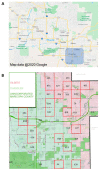Assessing Near-Infrared Spectroscopy (NIRS) for Evaluation of Aedes aegypti Population Age Structure
- PMID: 35447802
- PMCID: PMC9029691
- DOI: 10.3390/insects13040360
Assessing Near-Infrared Spectroscopy (NIRS) for Evaluation of Aedes aegypti Population Age Structure
Abstract
Given that older Aedes aegypti (L.) mosquitoes typically pose the greatest risk of pathogen transmission, the capacity to age grade wild Ae. aegypti mosquito populations would be a valuable tool in monitoring the potential risk of arboviral transmission. Here, we compared the effectiveness of near-infrared spectroscopy (NIRS) to age grade field-collected Ae. aegypti with two alternative techniques-parity analysis and transcript abundance of the age-associated gene SCP1. Using lab-reared mosquitoes of known ages from three distinct populations maintained as adults under laboratory or semi-field conditions, we developed and validated four NIRS models for predicting the age of field-collected Ae. aegypti. To assess the accuracy of these models, female Ae. aegypti mosquitoes were collected from Maricopa County, AZ, during the 2017 and 2018 monsoon season, and a subset were age graded using the three different age-grading techniques. For both years, each of the four NIRS models consistently graded parous mosquitoes as significantly older than nulliparous mosquitoes. Furthermore, a significant positive linear association occurred between SCP1 and NIRS age predictions in seven of the eight year/model combinations, although considerable variation in the predicted age of individual mosquitoes was observed. Our results suggest that although the NIRS models were not adequate in determining the age of individual field-collected mosquitoes, they have the potential to quickly and cost effectively track changes in the age structure of Ae. aegypti populations across locations and over time.
Keywords: NIRS; SCP1; Sonoran; aging; mosquito; parity.
Conflict of interest statement
The authors declare no conflict of interest.
Figures





Similar articles
-
Near-Infrared Spectroscopy, a Rapid Method for Predicting the Age of Male and Female Wild-Type and Wolbachia Infected Aedes aegypti.PLoS Negl Trop Dis. 2016 Oct 21;10(10):e0005040. doi: 10.1371/journal.pntd.0005040. eCollection 2016 Oct. PLoS Negl Trop Dis. 2016. PMID: 27768689 Free PMC article.
-
Field validation of a transcriptional assay for the prediction of age of uncaged Aedes aegypti mosquitoes in Northern Australia.PLoS Negl Trop Dis. 2010 Feb 23;4(2):e608. doi: 10.1371/journal.pntd.0000608. PLoS Negl Trop Dis. 2010. PMID: 20186322 Free PMC article.
-
The Influence of Diet on the Use of Near-Infrared Spectroscopy to Determine the Age of Female Aedes aegypti Mosquitoes.Am J Trop Med Hyg. 2015 May;92(5):1070-5. doi: 10.4269/ajtmh.14-0790. Epub 2015 Mar 23. Am J Trop Med Hyg. 2015. PMID: 25802436 Free PMC article.
-
Use of a Miniature Optical Engine for Age Classifying Wild-Caught Coquillettidia perturbans in the Shortwave Infrared Region.J Am Mosq Control Assoc. 2023 Mar 1;39(1):18-30. doi: 10.2987/22-7079. J Am Mosq Control Assoc. 2023. PMID: 37043608
-
Ability of near-infrared spectroscopy and chemometrics to predict the age of mosquitoes reared under different conditions.Parasit Vectors. 2020 Mar 30;13(1):160. doi: 10.1186/s13071-020-04031-3. Parasit Vectors. 2020. PMID: 32228670 Free PMC article.
Cited by
-
Age structure of cohorts of mosquitoes from the field using shortwave infrared spectroscopy before and after ULV adulticide treatment.Parasit Vectors. 2025 Jul 1;18(1):250. doi: 10.1186/s13071-025-06873-1. Parasit Vectors. 2025. PMID: 40597253 Free PMC article.
-
Differences in Longevity and Temperature-Driven Extrinsic Incubation Period Correlate with Varying Dengue Risk in the Arizona-Sonora Desert Region.Viruses. 2023 Mar 26;15(4):851. doi: 10.3390/v15040851. Viruses. 2023. PMID: 37112832 Free PMC article.
-
Estimation of population age structure, daily survival rates, and potential to support dengue virus transmission for Florida Keys Aedes aegypti via transcriptional profiling.PLoS Negl Trop Dis. 2024 Aug 13;18(8):e0012350. doi: 10.1371/journal.pntd.0012350. eCollection 2024 Aug. PLoS Negl Trop Dis. 2024. PMID: 39137188 Free PMC article.
-
Using body size as an indicator for age structure in field populations of Aedes aegypti (Diptera: Culicidae).Parasit Vectors. 2022 Dec 22;15(1):483. doi: 10.1186/s13071-022-05605-z. Parasit Vectors. 2022. PMID: 36550576 Free PMC article.
-
Autofluorescent Biomolecules in Diptera: From Structure to Metabolism and Behavior.Molecules. 2022 Jul 12;27(14):4458. doi: 10.3390/molecules27144458. Molecules. 2022. PMID: 35889334 Free PMC article. Review.
References
-
- Dentinova T. Age-Grouping Methods in Diptera of Medical Importance. World Health Organization; Geneva, Switzerland: 1962. - PubMed
Grants and funding
LinkOut - more resources
Full Text Sources
Miscellaneous

